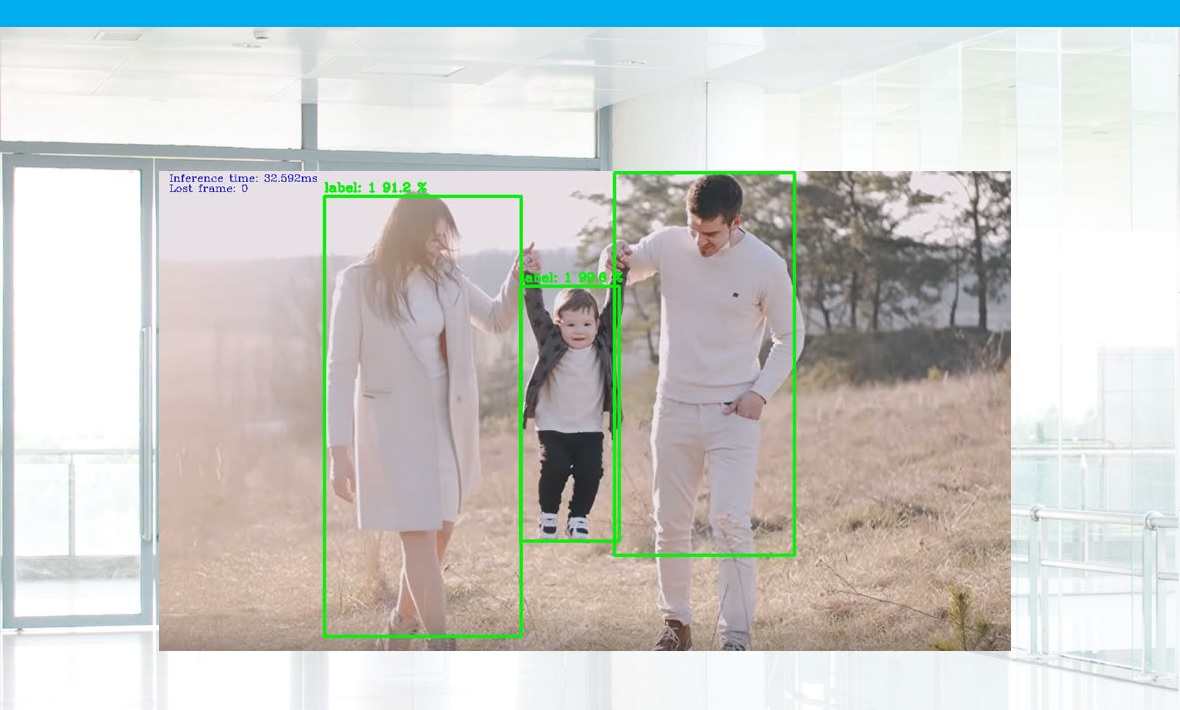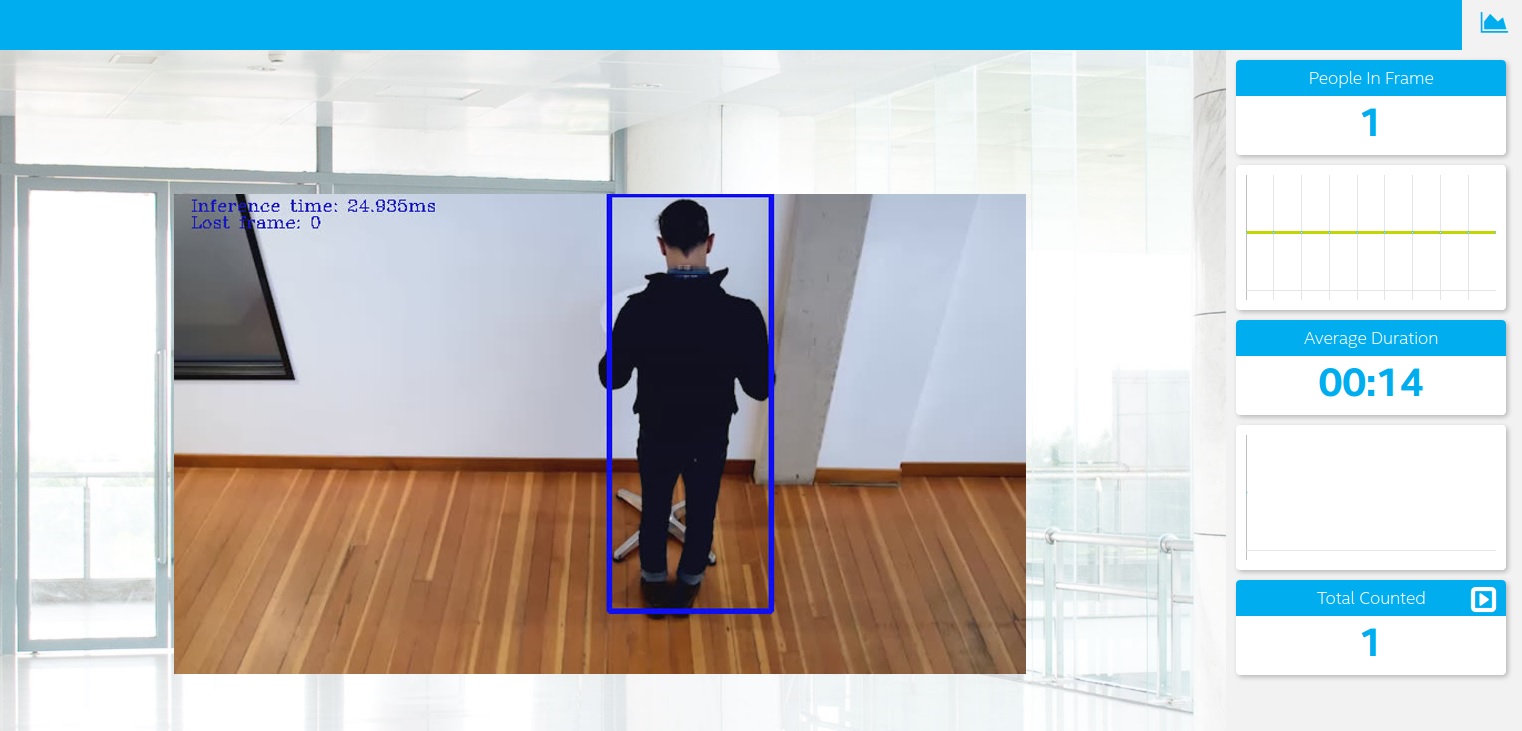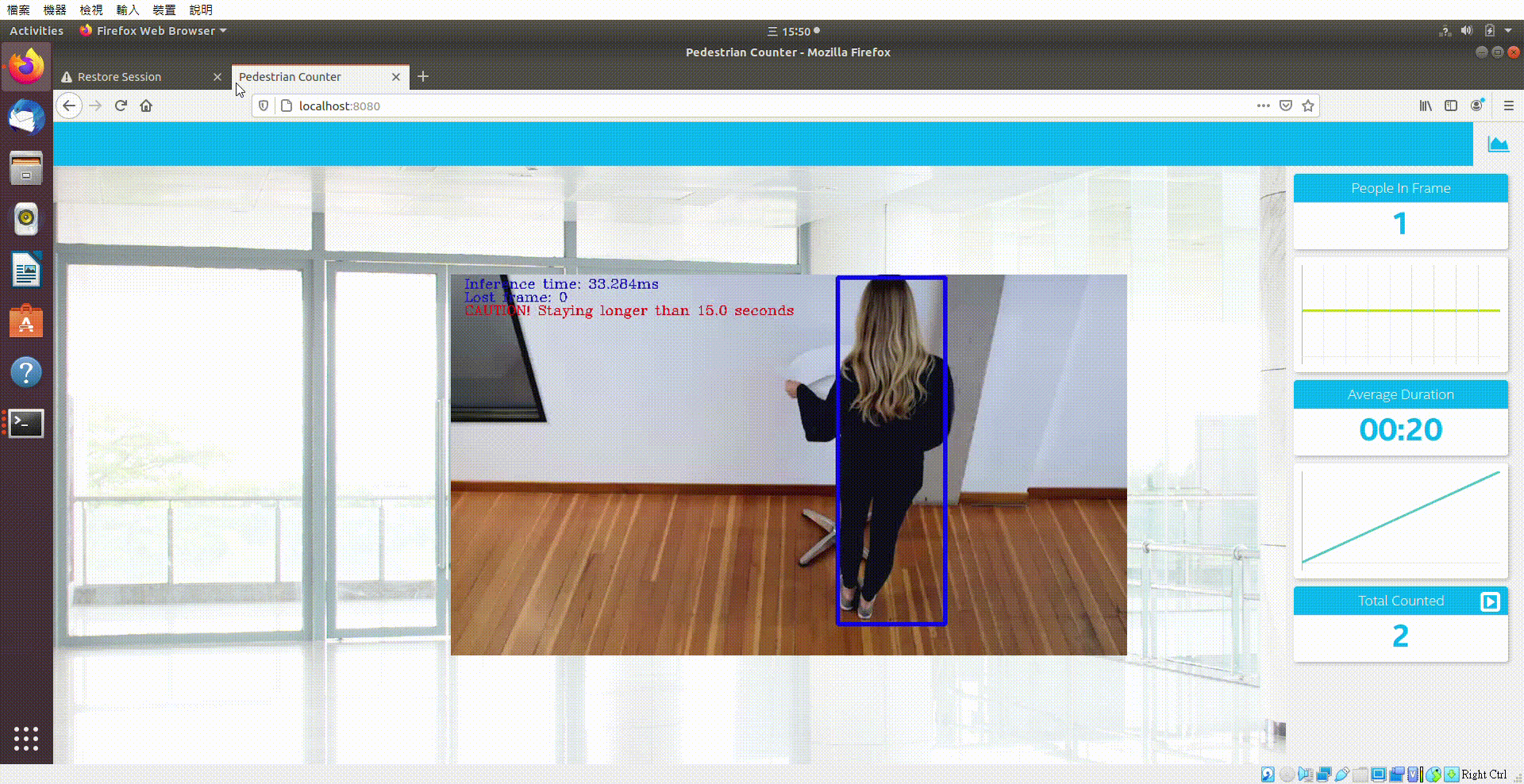| Details of Software | |
|---|---|
| OS: | Ubuntu* 18.04 LTS |
| OpenVINO: | 2020.3 LTS |
| Python: | 3.6.9 |
The solution of people counter application demonstrates a smart video IoT using Intel® hardware and software tools. It detects people in a designated area, providing the number of people in the frame, average duration of people in frame, and total count.
The use cases of a people counter app are quite extensive, such as shopping malls, metro station, retail chain, public venue, bank, and so on. For instance, once a person is detected, we can follow the individual’s behavior to further collaborate with union to take actions if required.
In this case, we customize an alert time to print out ‘CAUTION’ if the assigned threshold is crossed. It can check if a person is staying longer than normal period of duration in a frame, then maybe we shall be aware of potential incident happened shortly.
By leveraging inference engine with a DNN model (pre-trained), this solution can detect people within a designated area by displaying a bounding box over them.
Specifically, the main functions of the counter are:
- Counting number of people in a current frame.
- Calculating the duration that a person is in the frame.
- Summing the total count of people from the starting point.
Then, the app will send the data to a local web server using the Paho MQTT Python package.
- 6th to 8th generation Intel® Core™ processor with Iris® Pro graphics or Intel® HD Graphics.
- Intel® Integrated GPUs, or VPUs (NCS2).
-
Note: 4.14+ Linux kernel is recommended. Run the following command to view the kernel version:
uname -a -
Intel® Distribution of OpenVINO™ toolkit 2020.3 LTS release
To verify the OpenVINO version:
ls -al /opt/intel/openvino -
Python 3.5 or newer
To check the Python version:
python3 --version -
Node v6.17.1
-
Npm v3.10.10
-
MQTT Mosca* server
The detailed guide of installing Intel® Distribution of OpenVINO™ toolkit for Linux* can be referred to here.
- To install Nodejs and Npm, run the below commands:
curl -sSL https://deb.nodesource.com/gpgkey/nodesource.gpg.key | sudo apt-key add - VERSION=node_6.x DISTRO="$(lsb_release -s -c)" echo "deb https://deb.nodesource.com/$VERSION $DISTRO main" | sudo tee /etc/apt/sources.list.d/nodesource.list echo "deb-src https://deb.nodesource.com/$VERSION $DISTRO main" | sudo tee -a /etc/apt/sources.list.d/nodesource.list sudo apt-get update sudo apt-get install nodejs
sudo apt update
sudo apt-get install python3-pip
pip3 install numpy
pip3 install paho-mqtt
sudo apt install libzmq3-dev libkrb5-dev
sudo apt install ffmpeg
1. Clone this repository to desired location:
git clone https://github.com/jonathanyeh0723/OpenVINO_People_Counter_App
2. Source the OpenVINO environment
source /opt/intel/openvino/bin/setupvars.sh
We should be able to see the following returned, if it is successful:
[setupvars.sh] OpenVINO environment initialized
3. Install npm
There are three components that need to be running in separate terminals for this application to work:
- MQTT Mosca server
- Node.js* Web server
- FFmpeg server
Go to people-counter-python directory
cd OpenVINO_People_Counter_App/people-counter-python/
-
For mosca server:
cd webservice/server npm install -
For Web server:
cd ../ui npm installNote: If any unexpected configuration errors occur while using npm install, use the below commands for debugging:
npm cache clean --force rm -rf node_modules package-lock.json sudo npm install -g n --force sudo n stable npm installThe related issue can be found here on Stack Overflow.
Before running the main function, you will need to have the MQTT, FFmpeg and UI servers all up and running.
Concretely, we’ll have to configure the environment in 4 terminals separately to enable the people counter app.
cd webservice/server/node-server
node ./server.js
You should see the following message, if successful:
connected to ./db/data.db
Mosca server started.
cd webservice/server/ui
npm run dev
You should see the following message in the terminal.
webpack: Compiled successfully
cd people-counter-python/
sudo ffserver -f ./ffmpeg/server.conf
You should see the following message in the terminal.
FFserver started.
Note: Prior to execute the main thread, we must initialize the OpenVINO environment by running the following command:
source /opt/intel/openvino/bin/setupvars.sh
cd people-counter-python/
python3 main.py -m model/person-detection-retail-0013/person-detection-retail-0013.xml \
-i resources/family.jpg \
-d CPU \
-pt 0.6 \
| ffmpeg \
-v warning \
-f rawvideo \
-pixel_format bgr24 \
-video_size 1269x710 \
-framerate 24 \
-i - http://0.0.0.0:8090/fac.ffm
Or, simply perform the shell script including the above commands:
./exec_image.sh
To actually see the output on a web based interface, open the browser and type in http://localhost:8080/.
cd people-counter-python/
python3 main.py -m model/person-detection-retail-0013/person-detection-retail-0013.xml \
-i resources/Pedestrain_Detect_2_1_1.mp4 \
-d CPU \
-c BLUE \
-at 15.0 \
| ffmpeg \
-v warning \
-f rawvideo \
-pixel_format bgr24 \
-video_size 768x432 \
-framerate 24 \
-i - http://0.0.0.0:8090/fac.ffm
Or, simply perform the shell script including the above commands:
./exec_video.sh
To actually see the output on a web based interface, open the browser and type in http://localhost:8080/.
- Test and compare the performance among different models.
- Try various hardware plugin on Intel DevCloud. Find out the best fit and then deploy it to the edge.
- Implement in other scenarios, i.e. metro system.
-
This project originates from Udacity NANODEGREE PROGRAM - Intel® Edge AI for IoT Developers.
-
The People Counter Solution is provided by Intel®.






